The
Third WASWAC World Conference was Successfully Held
The 3rd WASWAC
World Conference was held in Belgrade, Serbia, during the period of Aug. 22-26,
2016. The theme of the conference is “New Challenges and Strategies of Soil and
Water Conservation in the Changing World, Sustainable Management of Soil and
Water Resources”. This conference was organized by the World Association of
Soil and Water Conservation, Sub-committee on Belgrade University – Faculty of
Forestry. The cooperating organizations include 15 government agencies or
academic societies distributed in Serbia, Spain, Italy, and USA. About 200
participants from 33 counties or regions attended this conference.
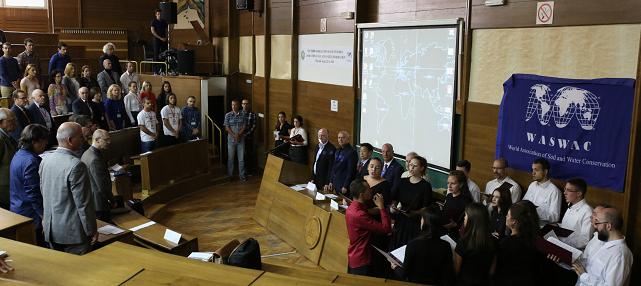
Sing
the national authem of Serbia at the WASWAC WC III opening ceremony
On the opening
ceremony, Prof. Li Rui, the president of WASWAC, Miodrag Zlatic President
of Organization Committee of WASWAC Conference gave the welcome speech. Besides
the keynotes speech by Dr. Panos Panagos from European Commission in Italy
Prof. Miodrag Zlatic from University of Belgrade, Prof. Guobin Liu from
Institute of Soil and Water Conservation, China, Prof. Mingchang Shi from
Beijing Forestry University, and Prof. Jose Luis Rubio from University of
Valenciana, Prof. Rathan Lal in the Ohio State University, USA made video
report with title “Conserving Soil and Water Resources for Climate-Resilient
Agriculture”.
Dean of the
Faculty of Forestry Belgrade University prof. Ratko Ristid, State Secretary of
the Ministry of Education, Science and Technological Development Vera Dondur;
Assistant Minister of the Ministry of Education, Science and Technological
Development Viktor Nedovid; Representative of the Ministry of Agriculture and
Environment Protection, Directorate for watersNata?a Milid; Deputy Mayor of the
City of Belgrade Andreja Mladenovid; President of ESSC Prof. Carmelo Dazzi;
Secretary of Secretariat for Environment, Belgrade Goran Trivan; Director of
Institute for Forestry Ljubinko Rakonjac; Director of Public Enterprise Serbian
Forests Predrag Aleksid; Director of Water Management Institute “Jaroslav
Cerni” Milan Dimkid; Director of the Institute for Nature Conservation of
Serbia Aleksandar Dragi?id; President of Organization Committee of WASWAC
Conference attended the opening ceremony.
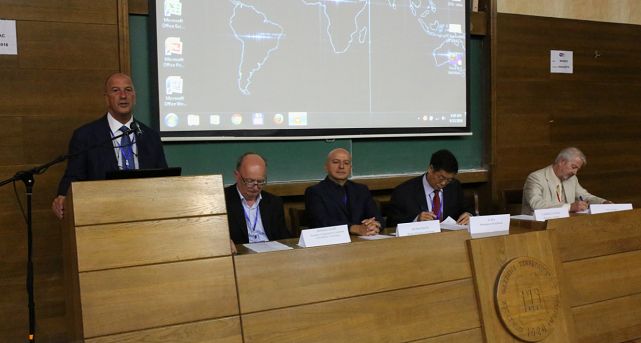
Speech provided by Prof. Carmelo Dazzi
The three days
conference provided an output of deep plenary sessions based on the issues
collected following topics: new challenges to soil and water resources in
condition of climate change, land degradation processes and mechanism, soil and
water conservation measures benefits assessment, sustainable watershed
management, social and economic aspects, and policies related to soil and water
conservation.
The
Award-winner for several awards set up by WASWAC has been released by thesecretary-general
of WASWAC Prof. Duihu Ning. During the conference, the 2016 Outstanding Youth
Paper Award (Datum) was also presented with a Certificate from the WASWAC and a
$1000 (USD) honorarium for each winner. This year, there are 10 young
scientists from 6 countries won the award.
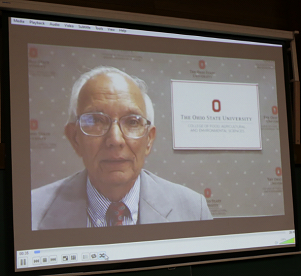
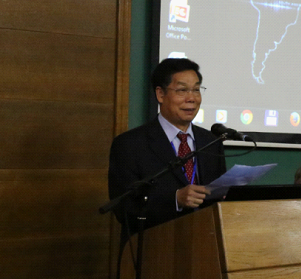
Video presentation by Prof. Rattan Lal
Welcome speech by President Li Rui
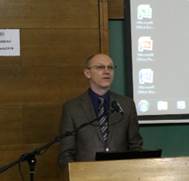
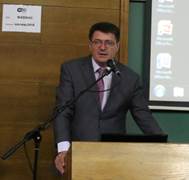
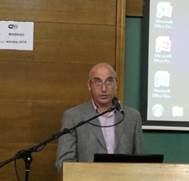
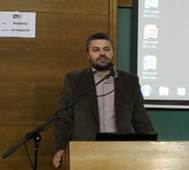
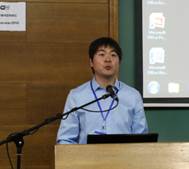
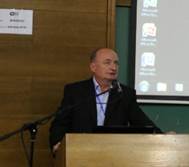
A glance of speeches
Most
participants attended the post-conference tour on Aug. 26 to visit the center
of the Agriculture Faculty–Radmilovac, vineyards and orhards on
terraces.Measures to control soil and water loss were discussed and
communicated.
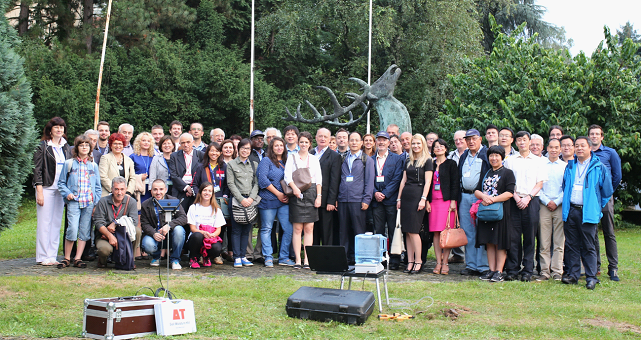
Group Photo during the Field Trip
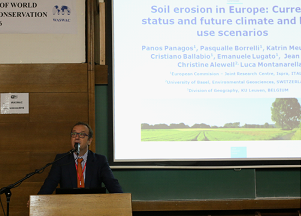
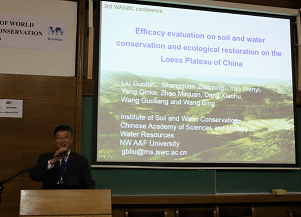
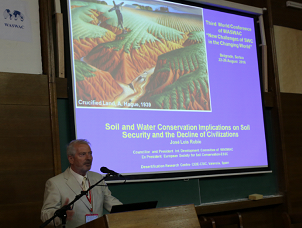
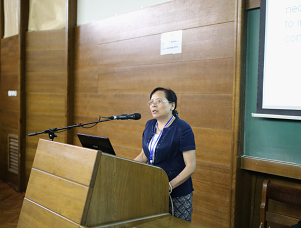
Presentations
Detailed Report on WASWAC WC III
President of Organizing Committee of WASWAC
Conference
Prof. Miodrag D. Zlati'c, D. Sc.
Immediate Past President of World
Association of Soil and Water Conservation
Belgrade University
Faculty of Forestry, Kneza
Vi?eslava 1, 11030 Belgrade, Republic of Serbia
Belgrade
University - Faculty of Forestry, in cooperation with the World Association of
Soil and water Conservation, organized third conference of this association in
Belgrade from August 22-26.2016.
The Conference
was dedicated to the protection of soil and water resources and to the degradation
factors and practical measures against adverse impacts through following
topics:
-
New
challenges to soil and water resources in condition of climate change
-
Land
degradation processes and mechanism
1) Causes of Land
Degradation 2)
Modeling Water Erosion
-
Soil
and water conservation strategies to adapt and mitigate climate change
- Soil
and water conservation measures benefits assessment
1) Soil properties
- Sustainable
watershed management
1) Erosion Control
- Social
and economic aspects and policies related to soil and water conservation
At the opening
ceremony, Dean of the Faculty of Forestry Ratko Risti? opened the
Conference and welcome speeches also gave Assistant Minister of the
Ministry of Education Viktor Nedovi?, President of WASWAC Li Rui, President of
ESSC Carmelo Dazzi, Secretary of Secretariat for Environment of Belgrade Goran
Trivan, Director of Institute for Forestry Ljubinko Rakonjac, Director of the
Institute for Nature Conservation of Serbia Aleksandar Dragi?i?, Representative
of Water Management Institute “Jaroslav Cerni” Milutin Stefanovi?
, President of
the Organising Committee of WASWAC Conference Miodrag Zlati? and President of
International Youth Forum of SWC Bin Wang.
In the working part
of the Conference, first plenary session started with the presentation of Ratan
Lal, the highest world authority on the topics of erosion and erosion control.
Within the same session, there were presentations of Miodrag Zlati?, Panos
Panagos, Guobin Liu, Minchang Shi and Jose Rubio that obtained topics of
demographic trends in the context of climate change and sustainable soil
management, then erosion processes in Europe, as well as the influence of SWC
on soil security.
Special attention
was dedicated to the International Youth Forum of SWC, where 10 best papers
were awarded with the price of 1000 USD by the foundation of the Chinese
Institution DATUM.
Plenary sessions of
the topics were organized after paper presentations. Moderators/chair persons
of the topics/sessions gave reports at the closing ceremony as following:
1.REPORT of Topic A: New
challenges to Soil and Water Resources in Condition of Climate Change
Moderator: Prof. Winfried Blum
The key issue
of this session, with 3 presentations, was the role of soil in the mitigation
of climate change through C-sequestration.
Starting from
the political statement of Stéphane le Foll,French Minister of Agriculture
during the World Climate Conference in Paris in December 2015 = 4/oo addition
of organic C to soils annually, we discussed the time scale and the quantity of
C-sequestration of soils under forest and agricultural management.
As a result,
it became clear, that C-sequestration is a complex process, which is primarily
dependent on soil texture, which determines the mineral surfaces, available for
the fixation of organic C. – Another most important parameter is the quantity
and quality of annual C-input from plant and animal residues. Moreover, the
annual temperature regime influences the biological turnover rates, reducing
the C-sequestration in case of higher temperatures and favoring sequestration
at lower temperatures.
Therefore, we
recommend to study first the prevailing local site conditions (soil and
climate) before formulating standard values, which in reality don’t meet the
local conditions of C-sequestration.
The stipulated
value of annual C-accumulation of 4/oo seems to be very high and not reachable
under average soil and climatic conditions.
2.REPORT of Topic B. Land degradation processes and mechanism
B1 - Causes of land degradation
Moderators: Miroslav Dumbrovsky and Xiaoyu Wang
In the session
with topics causes of land degradation make presentations 9
presenters, 7 of them were focused on soil degradation, one focused on the
degradation due to mining activities and one was directed to degradation
due to chemical contamination. It shows that, the issue of land degradation
problems is mostly a problem of soil degradation.
Land
degradation, due to adverse effects of human activities, was a
major global issue during the 20th century and will remain for solving in the
21st century. The importance of land degradation among global issues is
very high because of its impact on food security (Land degradation
through soil degradation is causing losses on crop
productivity) and quality of the environment, through the decreasing
quality of soil and water (especially water resources).
Land
degradation is equal to Soil degradation
Soil
degradation – degradation of the complex of physical, chemical,
biological properties.
-
Physical
properties are damaged and negatively changed due to collapse of
soil structure leading to crusting, compaction, desertification, and have an
adverse impact on natural resources.
-
Degradation
of chemical properties includes leaching, acidification, salinization,
and fertility losses
Biological
degradation includes decreasing of biological activity of
soil due to decreasing organic matter and humus content.
Recently there
has been a serious problem of greatly expanded production of biofuels and
bioenergy from field crops. The result is accelerated soil degradation.
Is it ecological in nature and the landscape? Is it economical? Is
it sustainable? The damages (on and off site) are greater than the
benefits.
There are two
basic steps involved in the process of decreasing the problem:
An effective
soil conservation requires an appropriate complex system of measures in the
landscape. They are also important to continue to develop new sophisticated
methods and technologies for decreasing land degradation.
System of
soil conservation solving land degradation depends on the ability and the
willingness of land users to apply them. When we talk about land degradation,
it is not just a technical issue, but also an economic and political issue.
From a technical point of view, we've already made many positive steps, but for
successful solving the problem of land degradation is necessary to develop
suitable economic and political tools to increase the willingness and ability
of land users to adopt conservation measures.
3.REPORT of Topic B2 (a): Erosion modelling
Moderators: Valentin Golosov and Ivan Blinkov
15 presentations were
listening during four sessions.
Different aspects of
erosion modelling were discussed, including:
1)Application
empirical erosion models for the quantitative assessment of erosion rates in
different scales, starting from a continent or Russian Plain up to small
catchments.
2)Elaboration
of physical based erosion models using experimental observations for
description of different erosion and deposition processes. New approach for
quantitative assessment of sediment and nutrient transport through vegetation
buffer strips, different equations for assessment of raindrop effect on erosion
rates; spatial –temporal variations 0f rainfall erosivity in different regions.
3)Modelling
and evaluation of climate changes influence on the erosion rates in different
regions of the world (China, European part of Russia)
4)Erosion risk
assessment in mountains area and consequences of extreme erosion events
(Bulgaria Macedonia)
5)Influence of
relief parameters on the erosion rate, sediment transport and CO2
6)Analysis of
long-term trends of river water and sediment discharges in context of
assessment of erosion rate trends within their basins (Serbia, Macedonia and
Russia)
Based on the presentations
and experience of session participants different recommendations were
suggested, including:
1)Erosion
modelling results should be validated based on the results of erosion
monitoring and application of the set of independent field methods of erosion
and deposition rate evaluation.
2)It is
strongly supported idea for organization multi-national monitoring center in
different landscape zone, where different methods and approaches of erosion rate
assessment may be tested together with field monitoring of sediment
redistribution on the plots, field catchments and small river basin scales.
Other earth sciences disciplines can organize their monitoring in such centers.
Given monitoring center can be used for training student and researchers from
developing countries and for organization of coordination, research program
meetings and workshop for unification of application of different erosion
models and field methods;
3)Very
important the application of the erosion model for prediction of possible
consequences of climate and land use changes on land degradation;
4)It was also
emphasized that more attention should be given to communication with
politicians and mass-media, adopted approaches should be used for explaining
the importance of erosion investigation and in particular application of
erosion models elaborated based on long-term monitoring data and field
and laboratory experimental information.
4.SESSION B2 (b) – Modeling water erosion
Moderator: Zheng Fenli and Sanja
Manojlovi?
There were more than 30 participants to attend our section, and 10
speakers made the presentations, among which, nine oral presentations and one
poster presentation. 10 speakers focused on the topics as follows:
1)Erosion process and
mechanisms, such as splash erosion and interrill erosion.
2)Quantifying
soil erodibility and rainfall erosivity.
3)Climate
Change, especially extreme climate event impacts on water erosion patterns and
sediment delivery.
4)Noe
technology development for measuring raindrop physical parameters, such as
raindrop distribution, velocity and energy.
5)Erosion modelling
development and application.
After we spent above one hour for deep discussion, we proposed the
following points for future study:
1)Developing new technology
for measuring and monitoring erosion process, especially gully erosion and mass
movement.
2)Soil
erodibilty variation with season and year.
3)Water
erosion response to climate change, especially in extreme rainfall events.
4)Rational use current
water erosion model to assess erosion risk and regional soil loss.
5.REPORT OF SESION B3 – LAND DEGRADATION PROCESSES AND MECHANISMS
Moderators: Stanimir Kostadinov and
Emilija Velizarova
Following the extensive
climatic changes it is expected, in the future, the increasing of natural
hazards and extreme events (erosion processes, torrential floods, landslides
and forest fires).
The recent prolonged
drought observed in different countries, it has affected the surface water
resources. The extreme rain events could cause flooding and thus deterioration
of the water quality.
Integrated management in
the watersheds is the best solution to mitigate the problems with extreme
events and its consequences (erosion processes, torrential
floods, landslides and forest fires).
In order to achieve the
required goals it is necessary for the governments to undertake the following
activities:
1.The change of the legislature with the aim to
increase the works on the prevention of natural hazards:
2.Organisational
and administrative measures; Having in mind that extreme events cause damage to the economy and
the society in general, the works on erosion and torrential flood control, and
other extreme events, should be financed from all economy sectors: water
management, forestry, agriculture, energy sector, urban planning, traffic, as
well as all others which suffer from the damages caused by torrential floods
and soil degradation.
3.The preparation of strategic
documents to
mitigate extreme events in
order to decrease the economy and social effects.
4.The realization of “horizontal
and vertical” coordination at the level of the competent authorities
(Governmental bodies) concerning the coordination of organizational units
within water management, forestry, agriculture and others in order to achieve
the adequate treatment of the area around mountainous basins concerning
prevention of natural hazards.
5.Establishing continuous
monitoring and early warning systems of the occurrence and effects of natural
hazards in order to provide a full scale description of the problems at hand
and further on to mitigate and cope with future events.
6.Research and application of new
methods and technologies to mitigate climate change and coping with extreme
events
7.Building capacities, knowledge
improvement at all levels, starting with local inhabitants through to
respective authorities
Establishing
a special fund for: Implementation of financing activities, for communication,
prevention and direct action during and after extreme events.
6.REPORT of Topic C: Soil and water conservation strategies to
adapt and mitigate climate change
Moderators: Ruslan Sulejmanov and
Mirjana Todosijevi?
5 presentations were
listening during topic C.
Conservation
practices for mitigation and adaptation to a changing climate: Sustainable
solutions.
Problems:
-
The soil erosion in relation to food and
water security, does not being properly recognized as a huge problem.
-
The negative
impact of the climate changes is evident.
-
Soil erosion
(especially wind erosion, which causes damage to the economy caused by moving
sand).
-
The
investment in soil conservation and reduction of the process of soil erosion.
-
The poor
social status of local community in the rural area
-
The lack of
working force, caused by the one-way permanent migration of the working age
population from rural to urban areas and consequent depopulation of rural
areas.
-
Unsuitable
habitat conditions in the area of sands and degraded land.
-
The lack of
practical experiences and measures in the case of sustainable use of sands and
degraded land.
-
The low degree of exchange experiences
between international subjects
Suggestion:
Implementation of the new practices and technologies
o In case of agricultural production:
-
Production on sustainable principle,
-
Agriculture management and no-till systems,
-
Intercropping of field crop with cash crop.
o In case of afforestation:
with
the profitable species (fruit) for producers/farmers, which affects the
prosperity of the region.
-
Further,
following of non native species that strengths and threats (‘ST’) strategies
are dominant in all three prospects: ecology, silviculture and climate changes.
-
There is an obvious need for exchanging
experiences between international subjects.
7.REPORT of Topic D. Soil and
water conservation measures benefits assessment
D1 – Soil properties
Moderators: Ju-Ying Jiao and Maria
Konstantinova Ivanova
6 speakers arranged, 3
speakers give presentations, 17 attendees
In the
Chinese hill and gully Loess Plateau:
Soil erosion resulted in
seed redistribution and caused the seeds to concentrate in a trap or deposited
micro-sites.
Overland flow could not
result in large numbers of the seed loss and soil erosion is not the
limiting factor for natural vegetation recovery in the seed stage.
Other factors, such as
seed germination, seedling survival capacities, pioneer species dominated in
the soil seed bank, and water shortage may be the limiting factor for natural
vegetation recovery.
In Njona
river basin in Kenya:
Agriculture was the most
dominant land use.
There has been a
transformation from areas of traditional rural landscape in intensive
agriculture.
In 2000 to 2014,
commercial agriculture increased by 65% and subsistence agriculture by 21% with
the forest reducing by 64%.
In South
Moravia in the Czech Republic:
Chisel and disc plough
cause less soil translocation than does the mouldboard plough.
The shallow tillage
(<20cm depth) and up-slope tillage are recommended practice to reduce
tillage erosion.
Various agro-zones and
soil types, and the critical threshold for soil loss by tillage erosion
require further research.
8.REPORT OF Topic E. Sustainable watershed management
E1 - Erosion Control
Moderators: Ivan Blinkov and Jana
Podhrázská
River basins are the
dynamic systems constituted by a complex arrangement of fluxes between the land
and water environment. The great part of the eroded material ends the final
recipient. Studying the processes require as experimental works, as modeling
the runoff and erosion processes. The results showed a clear relation between
land cover/use and slope and the level of erosion and runoff. Protection of
land with vegetation is the primary factor in the fight against water erosion
with necessary application of biotechnical, technical, administrative and
planning measures. Works on protection from erosion and regulations of torrents
have influenced the decrease in erosion, as well as the reduction of the
maximum discharge value. In the case study in Serbia there was found out a
decrease of sediment transport for 3.5 times, then decrease of peak point for
20%. In the case study of Macedonia there was found out a reducing value in
sediment load in 30%, then also in Albania.Remedy of incurred damages is a
prolonged process, in case of loss of soil this is often irreversible process.
For objective and effective identification of measures leading to protect the
quality of water bodies, soil erosion control and to support the stabilization
of ecosystems it is necessary to have comprehensive information on the causes
of degradation processes, to be able to locate them at any level and prioritize
the application of measures. An appropriate tool for establishing of soil and
water conservation measures can be land consolidations, because the aim of this
process is not only to create conditions for rational farming but also for
improvement of environment and rural landscape development.
9.REPORT of Topic F(a): Sosial and Economic Aspects and Policies
Related to Soil and Water Conservation
Moderators: Carmelo Dazzi and Nada
Dragovi?
It is well established
that human well-being is dependent upon Soils and Water quality and
conservation.
The lack of understanding
of, and information on, the value of soil and water in providing ecosystem
services has generally led to their omission in public decision making.
During the topic F
presentations, several aspects were considered and several questions arose.
Soil scientists are convinced of the importance and relevance of soil and
water. Now, from the point of view of the social and economic aspects and
policies related to soil and water conservation, the problem is to convince the
others. The first skill of the soil scientist is to be able to improve the
societal perception of the importance of the soil and water.
We must start to consider
the soil and the water not only as natural resources, but mainly as economic
resources !!
For 3 reasons !
1.Because we face problems and
priorities, resulting from scenarios involving soil and water conservation,
which are functions of the perception that, in the different social context,
people has on soil and water;
2.Because the perception of soil and
water was traditionally linked to the agriculture, ignoring that actually soil
functions support in a more or less evident way, all human activity.
3.Because in recent years we experienced
that, the attempt to spread the culture of the soil is a difficult task,
especially if the "insiders" are the only ones who talk about soil
and its conservation.
It is therefore a priority
to widen and raise awareness among citizens and administrators on the
importance of soil and its water, involving different expertise.
In this context,
International scientific societies such as WASWAC and ESSC can play an
important role in bringing together experts from several disciplines (such as
environmental engineers, environmental economists, epidemiologists, physicians)
to be able to give not only a social but also an economic added value the soil
and to the water so that these resources can acquire more and more
consideration in all spheres of the society.
10. REPORT of
Topic F(b): Social and Economic Aspects and Policies Related to Soil and Water
Conservation
Moderators: Ildefonso Pla Sentis and
Dragoljub Todi?
From the presentations
(Keynote and regular) and the discussion among attendants to the discussion
session, it may be concluded:
- Social and economic factors are usually very
important and even determinant, both in the development of soil and water
conservation problems and on the adoption and application of soil and water
conservation practices
- Still nowadays, the problems of soil and water
degradation and their catastrophic consequences like droughts, floodings,
landslides, etc, are in most of the occasions related or a consequence of non
adequate occupation, use and management of the land, derived of population
pressure and related social and economic factors, and not so much, as it is
usually attributed, a consequence of anthropologically induced climate changes.
This confusion, generally based on interest to drive public opinion and
political interests, leads in many cases to non adequate policies and
measures to prevent or to solve those problems.
- The required social and economic studies and
evaluations in relation to soil and water conservation must be accompanied by
concurrent field studies of the particular biophysical conditions, mainly the
ones related to soils, climate and topography affecting the hydrological
balances and processes in the zone being evaluated. This in order to correct
the usual application of empirical generalized conservation practices, without
enough local required information and research to select or develop the most
appropriate for each case, leading in many cases to catastrophic consequences.
- The very common use of empirical model to evaluate
and predict soil and water degradation problems and their consequences, may
lead frequently to non adequate prevention or control measures, unless those
models are adapted to the local conditions, including local information on
soils, climate etc, with a previous strict validation.
- In general, it required a better
understanding of the relationships between global warming and other human
socioeconomic factors and their relative influence on soil and water
degradation processes leading to natural disasters, for better policies and
decisions to prevent them. The present tendency to rely only on the potential
previewed future human-induced climate changes for guiding research, and
preventive policies and actions is not justified and has proved to be non very
effective.
The main proposal of
WASWAC is establishing global program/project in mapping and assessing erosion
hazard and use of contemporary protection technologies.
Besides of professional,
conference had also socio-cultural character. It was organized sightseeing of
Belgrade. Welcome dinner was organized on the boat/ship “Kruna”.
Field trip was organized
at the last conference day partly in Vojvodina province. First, we visited the Residence
of Prince Milosh (Serbian:
Konak Kneza Milo?a) - a royal
residence in the Topchider
municipality of Belgrade,
Serbia.
It was originally used as the palace
of Prince Milosh Obrenovich. It was
built in 1831, after Serbia was given autonomous status
in the Ottoman
Empire. The grounds include a plane tree
over 160 years old, one of the oldest in Europe.
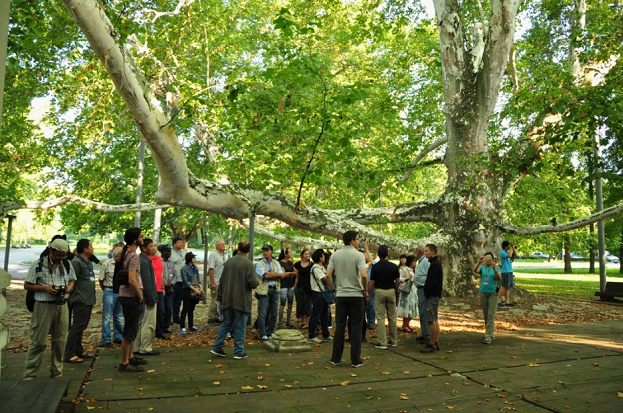
Nearby we visited
regulation of Topciderska river which is regulated from the mouth up to 12.8 km
by implementation of urban type of regulation, with prismatic, covered
riverbed. In the sector through the part of industrial area Rakovica, riverbed
is closed, as collector type. The upstream section of the river bed is not
regulated, overgrown by shrubs and grass, with reduced capacity for maximal
discharge.
We visited the
shelterlbelt on the way to the Dolovo settlement/village, which is about 30
years old. It consists of 2 rows of black walnut (Juglans nigra L.) and
3 rows of birch (Betula pendula Roth) on the left side of the road, and
2 rows of black pine (Pinus nigra Arnold) and 2 rows of birch (Betula
pendula Roth) on the right side of the road.
The shelterbelt width,
including the road area is about 50 m. The width of the shelterbelt on the left
side of the road is 14m, and 11m on the right side. The distance between the
trees in a row is 2.5 m on the left side, and 4 m on the right side. The
distance between the rows and the road is 3 m on both sides.
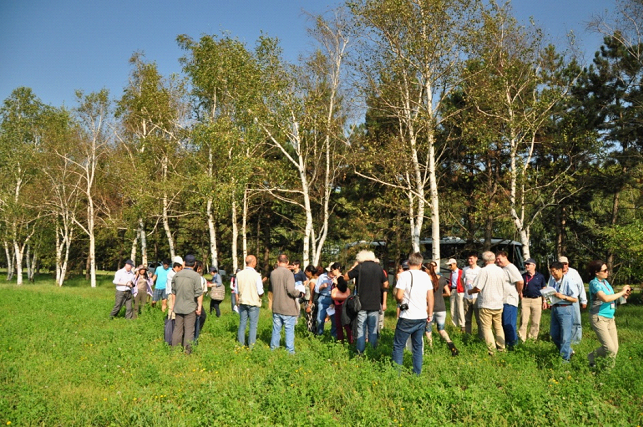
We
visited Viminacium - a major city (provincial capital) and military camp
of the Roman province of Moesia (today's Serbia), and the capital of Moesia Superior. The city dates back to the 1st century AD,
and at its peak it is believed to have had 40,000 inhabitants, making it one of
the biggest cities of that time. It lies on the Roman road Via Militaris. Viminacium was devastated by the Huns
in the 5th century, but was later rebuilt by Justinian. It was completely
destroyed by the arrival of Slavs
in the 6th century. Today, the archaeological site occupies a total of 450
hectares (1,100 acres), and contains remains of temples, streets, squares,
amphitheatres, palaces, hippodromes and Roman baths.
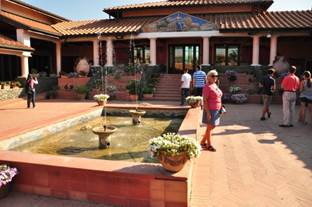
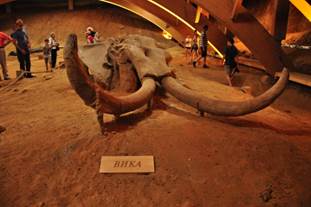
At the end of the field
trip we visited Radmilovac which is an organizational unit of the Faculty of
Agriculture. Part of the teaching, professional and production practices and
other forms of labor are performed at this estate as part of the curriculum of
undergraduate studies to meet the needs of the Faculty and other users. It is a
unique national resource in several areas of agricultural science.
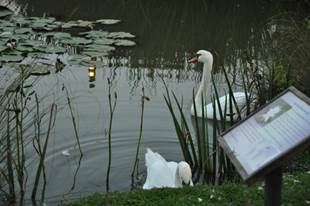
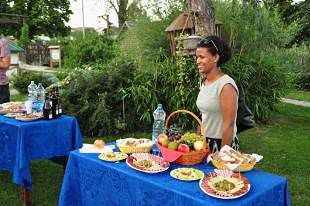
A significant part of EE
"Radmilovac" is the gene bank of fruit trees and vines used as a
source of genetic material for the improvement of various characteristics of
fruit trees and vines in combining genetic basis of available varieties,
biotypes and hybrids in the creation of new improved varieties of fruit trees and
vines. A total of 23 new varieties of vines (15 table varieties and 8 wine
varieties) and one variety of peach were created at EE "Radmilovac".
A total of 8 new clones of vines has been recognized, and a certain number of
new genotypes of cherry, sour cherry, apricot, raspberry and vine are in the
process of recognition.
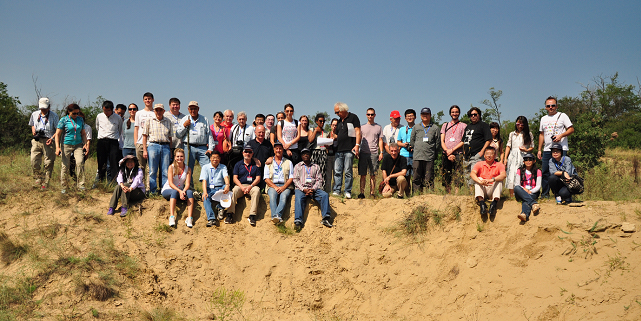
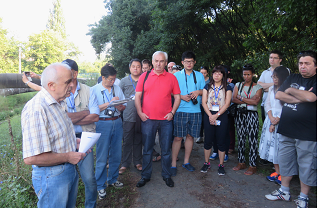
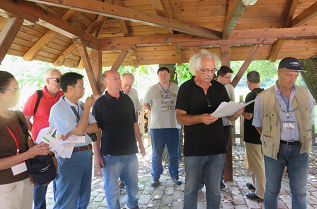
Good conference atmosphere
was concluded with “a glass of conversation”, by testing good sorts of wine and
discussing professional issues.

